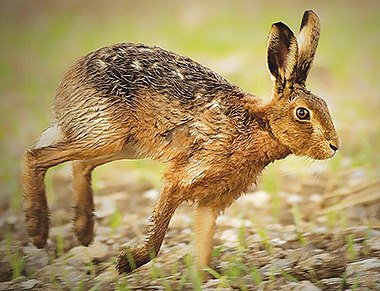Sussex Wildlife Trust: March Madness
March 1st, 2022 While the fields are still bare March is the best time to observe hares around Sussex.
While the fields are still bare March is the best time to observe hares around Sussex.I once had a girlfriend in the big city and found myself attending swanky dinner parties around East London. During one such soiree a guest, desperate to impress, boasted that for next week’s meal he would be cooking a hare.
Outraged, I asked if anyone at the table had actually seen a hare in the wild. My question was met with blank stares. I’d like to think that I then launched into an impassioned rant about the untamed magnificence of the hare and society’s disconnection with nature before heroically storming out.
In reality I knew there was going to be cheesecake for dessert so I wearily sighed and carried on eating. But I knew two things; hares don’t belong at Shoreditch dinner parties and neither did I; I never returned. I still maintain that if you’ve witnessed the reckless energy of a hare cavorting in a Sussex sunrise then the very idea of eating one is, well, madness.
While the fields are still bare March is the best time to observe hares around Sussex. On paper a hare could easily be dismissed as a big rabbit but they’re different beasts altogether; it’s all in the way they move. A hare possesses powerful hind legs; a pair of pistons that can send them rocketing towards the horizon at over 40 mph.
Hares are mostly nocturnal. They don’t burrow underground but instead spend their days hidden in a shallow scrape (a form). Young hares (leverets) are born in separate forms and attentive mother hares return to secretly suckle them undercover of dusk. In spring amorous male hares approach females in the hope of finding a mate but chatting up a hare is a risky business. Potential sexual partners can suddenly transform into sparring partners. Uninterested female hares rise up and strike a blow for equality by punching the males in the face. The frenzied ‘boxing matches’ that ensue are such a striking spectacle that they have given us the phrase ‘as mad as a March hare’.
Yet who are we to be questioning the hare’s mental stability? Us level-headed humans used to believe that sprinting hares can start fire, that eating hare brains made you sleep better and that witches could transform into hares and only be killed with silver bullets.
Hares have been closely associated with Pagan springtime fertility rituals and the goddess Eostre. and they still play a role in our Easter celebrations (albeit watered down, chocolate covered and transformed into the Easter Bunny). Their prominence in the English countryside has also diminished. Numbers have declined due to changes in farming practices, especially the removal of hedgerows.
It’s been a long winter and, as spring returns, the Sussex countryside will be exploding in a crazy celebration of life. Get out there, find yourself a hare and experience the madness.
By Michael Blencowe: Learning & Engagement Officer, Sussex Wildlife Trust
Sussex Wildlife Trust is an independent registered charity caring for wildlife and habitats throughout Sussex. Join Michael Blencowe on our regular wildlife walks and also enjoy free events, discounts on wildlife courses, Wildlife magazine and our guide book: Discovering Wildlife in Sussex.
It’s easy to join online at: www.sussexwildlifetrust.org.uk/join or T: 01273 497532
Sean Stones Sussex WildlifeTrust Hare
Outraged, I asked if anyone at the table had actually seen a hare in the wild. My question was met with blank stares. I’d like to think that I then launched into an impassioned rant about the untamed magnificence of the hare and society’s disconnection with nature before heroically storming out.
In reality I knew there was going to be cheesecake for dessert so I wearily sighed and carried on eating. But I knew two things; hares don’t belong at Shoreditch dinner parties and neither did I; I never returned. I still maintain that if you’ve witnessed the reckless energy of a hare cavorting in a Sussex sunrise then the very idea of eating one is, well, madness.
While the fields are still bare March is the best time to observe hares around Sussex. On paper a hare could easily be dismissed as a big rabbit but they’re different beasts altogether; it’s all in the way they move. A hare possesses powerful hind legs; a pair of pistons that can send them rocketing towards the horizon at over 40 mph.
Hares are mostly nocturnal. They don’t burrow underground but instead spend their days hidden in a shallow scrape (a form). Young hares (leverets) are born in separate forms and attentive mother hares return to secretly suckle them undercover of dusk. In spring amorous male hares approach females in the hope of finding a mate but chatting up a hare is a risky business. Potential sexual partners can suddenly transform into sparring partners. Uninterested female hares rise up and strike a blow for equality by punching the males in the face. The frenzied ‘boxing matches’ that ensue are such a striking spectacle that they have given us the phrase ‘as mad as a March hare’.
Yet who are we to be questioning the hare’s mental stability? Us level-headed humans used to believe that sprinting hares can start fire, that eating hare brains made you sleep better and that witches could transform into hares and only be killed with silver bullets.
Hares have been closely associated with Pagan springtime fertility rituals and the goddess Eostre. and they still play a role in our Easter celebrations (albeit watered down, chocolate covered and transformed into the Easter Bunny). Their prominence in the English countryside has also diminished. Numbers have declined due to changes in farming practices, especially the removal of hedgerows.
It’s been a long winter and, as spring returns, the Sussex countryside will be exploding in a crazy celebration of life. Get out there, find yourself a hare and experience the madness.
By Michael Blencowe: Learning & Engagement Officer, Sussex Wildlife Trust
Sussex Wildlife Trust is an independent registered charity caring for wildlife and habitats throughout Sussex. Join Michael Blencowe on our regular wildlife walks and also enjoy free events, discounts on wildlife courses, Wildlife magazine and our guide book: Discovering Wildlife in Sussex.
It’s easy to join online at: www.sussexwildlifetrust.org.uk/join or T: 01273 497532
Sean Stones Sussex WildlifeTrust Hare
Comments (0)
No comments have been submitted yet.Why not be the first to send us your thoughts
Leave A Comment
Thank you for your comments, they will appear shortly once approved.
Recent Posts
Have You Seen...






